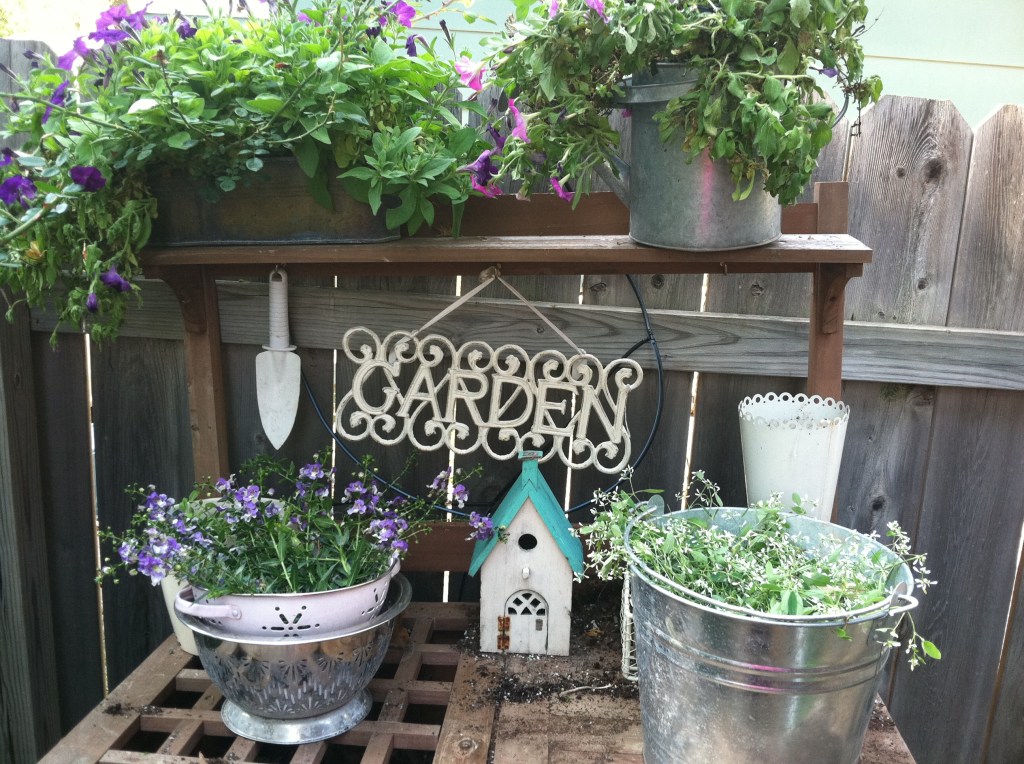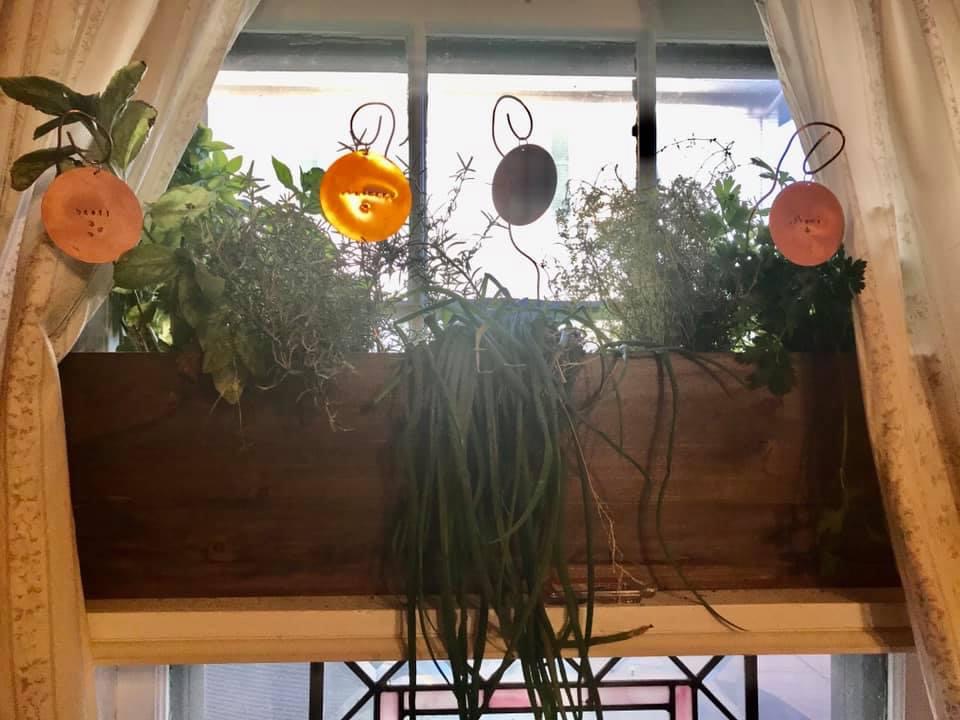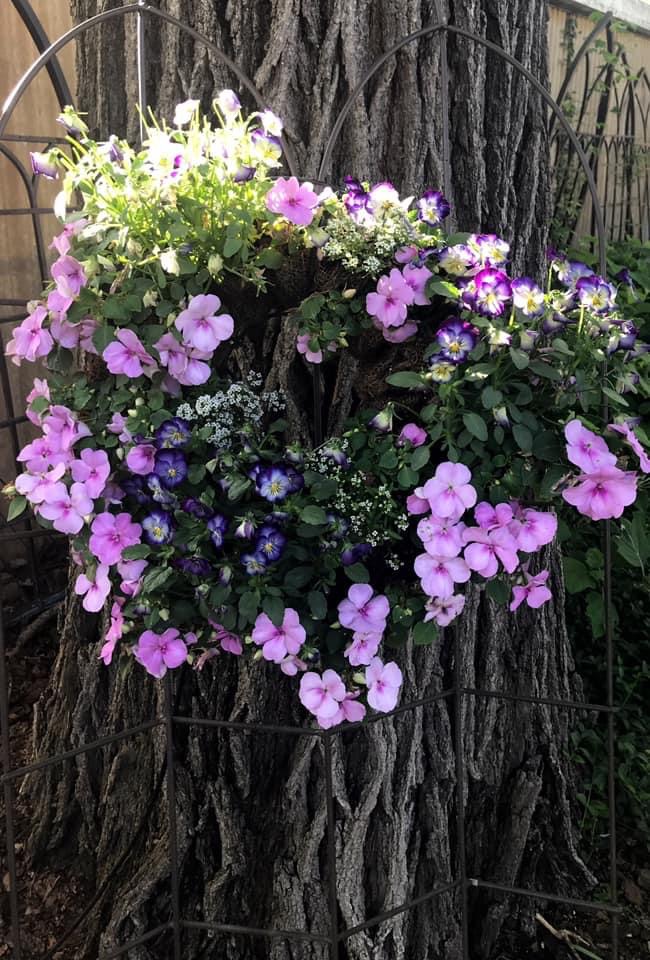If you are like me, a visit to a garden nursery can easily be an expensive outing. To create the garden of my dreams, it took both patience and thoughtful choices to get the most from my gardening dollar.

ACQUIRING PLANTS
Of course, you are most likely to spend most of your money at the garden nursery and there are many opportunities to save money while getting the plants you love.
Buy containers with multiple plants. By examining plants carefully, you will find some containers have 2-3 plants when other containers of the same plant only have one. This is especially common with vegetables like tomatoes, peppers, cucumbers, squash, and melons. When you buy a container with more than one of these types of plants, you can VERY carefully separate the roots and then plant the vegetables separately. See this marconi pepper? Maybe 25% of the containers that I looked at had two plants, but I looked them over carefully and walked away with two plants instead of only one.

Buy plants that are easily divided after purchase. Similarly, there are some plants which root along the surface of the container. If a thick enough mat forms, you can divide these plants into two or sometimes even more pieces with a pair of scissors. Some examples of plants for which this works include Creeping Jenny and dichondra. Select your plants carefully since some plants will have a thicker mat. Since you are destroying some of the roots, it helps to then cut the plant back by about a third. Similarly, if you inspect the base of a Dracaena spikes plant, you will see that some have divided into two parts that can be separated into more than one plant


.
Select annuals that will bloom all summer. Where I live, the summers get so hot, that certain plants peter out. Therefore, one way to save money is to mostly select annuals that do well in heat. See 10 Container Flowers that Bloom All Summer
Make the most of sales. The nurseries in my area have flat sales every year where I can get 36 plants for about $13-15 per flat. The selection is not great, but it is a good opportunity to stock up on 4 flats of impatiens which I use to provide the foundation for the more interesting plants that I grow. Having so many of the same plant also provides nice repetition throughout the garden, a core tenet of design. Even if your area doesn’t have flat sales, you can often buy similar types of plants at hardware stores. In addition, premium annuals often go on sale at a deep discount after 4th of July. You could buy a plant, enjoy it for about six weeks or so and then take cuttings to overwinter, assuming it is the type of plant for which this might work. To make this most of the sale strategy, keep records of purchases (what, where, when, and how much). If you see a good price on something you might want next year, try to take a quick note of the same information.
Don’t impulsively remove plants. When I moved into our house, there were hostas at the base of a large tree in our yard. I hate hostas and tearing those out was one of the first things I did. This ended up being a huge mistake because one plant after another failed in that spot. Eventually what did I successfully plant there? Hostas. I spent money on hostas when I could have just learned to love the free hostas that were free and growing there in the first place.

Propagating
Know which plants are best started from seed. It bothers me when I am at a nursery and see plants for sale that are very easily grown from seed and typically need to be planted in multiples. These plants include lettuce, spinach, basil, dill, parsley, beans, and peas. If you want to grow these plants, I would encourage you to consider buying seed and direct seeding them where they will grow for the season. The yield will be significantly higher than growing just one plant.

Root cuttings. Some expensive annuals can be rooted if you purchase them early enough in the season. I don’t recommend this if you need a large plant for a planter, but it can work well if a small plant will suffice. I have successfully started euphorbia cuttings in water and many others such as torenia, angelonia, coleus, and double impatiens by sticking cuttings in rooting hormone and then potting mix. Even better, take cuttings in fall and overwinter them indoors or in a greenhouse for the next season. For best success research the best propagation strategy for the plants you wish to root.



Divide your perennials. To thrive, some perennials benefit from dividing every few years. Once you have grown a plant for couple of years, you might be able to divide it to create more plants. In fact, one strategy is to buy one of several types of plants that appeal to you and then divide the plants you like and that have survived a couple of years later. Some perennials that you might like to divide are phlox, echinacea, yarrow and salvias. Many gardeners do not especially enjoy this task, so you might be able to score some free plants by dividing your friend’s or neighbor’s perennials such as salvia, echinacea, daylilies, and hostas. You might also keep an eye on social media, Craig’s list and Freecycle for offerings of free divisions.



Create new plants through layering. Dividing plants can be more work. First, they need to be dug up which isn’t too bad, but then those perennials need to be consistently watered the rest of that season. One way to get around this is to look for places where certain plants might have created new roots at an edge allowing you to cut a piece off with a sharp shovel and plant it elsewhere. You can even encourage this by cutting the leaves and piling some soil around the base of a plant. Some examples of plants that naturally layered for me include clematis, hydrangea, and vinca. I also was able to encourage this by taking the leaves off some clematis vines at the base and then using a garden staple to attach the base of the vine to the ground and covering up the base with some soil. Next year, I had a nice root that could be transplanted elsewhere. (photo of hydrangeas). To learn more, research layering.



Save kitchen scraps. I used to try to grow scallions from seeds, but had mixed success. Eventually, I realized that I could just plant scallions from the store if I didn’t think I was going to use them. I plant them in a windowsill over the winter. In spring, I harden that container off for a few days and then grow the scallions outside all summer. When I want some scallions, I can lift some out if I want the whites, but usually I just cut off some of the green. The green regenerates fairly quickly. Although I have read in several places that it is not recommended, I have also successfully grown potatoes that sprouted.

Preparing for Next Season
Save seeds. Certain plants are easy to save seeds from, but be sure to save seeds from open-pollinated plants, not hybrids. Just a few examples are certain varieties of tomatoes, peppers, peas, and beans. You might even be able to trade seeds with other gardeners.



Save small potatoes to grow next year. Every fall, when harvesting potatoes, I save the very smallest in a paper bag in a cool spot of my basement. Those potatoes sprout and grow stalks during the winter. As early as recommended the next spring, I very carefully plant those potatoes trying not to break the stalks.
Overwinter your favorite plants. If a plant is expensive, it might be worth trying to overwinter at least once just to see what happens. Certainly some plants are easier to overwinter than others. Without a doubt, I have had the greatest success with geraniums. One winter, I planted them in a window in my basement and forgot about them for months. To my great surprise, they were green when I found them and grew well after hardening off. I have also had success with euphorbia, double impatiens and heliotrope. You might do best if you take cuttings and grow them for a while outside in the fall before bringing the cuttings in.

Wintersowing. Without a doubt, one of the least known, least expensive, and greatest ways to create new plants is through wintersowing. Sometime after December 21, but before it gets too warm in the spring, you can sow seeds in moist soil in clear covered plastic containers such as the containers in which you might buy spinach or gallon milk jugs. The containers are then placed outdoors and, when conditions are right, the seeds will sprout. I usually only need to water these containers every few weeks at most when I see there is no more condensation on the lid. This method works well with many seeds, but I have the most consistent success with these seeds: kale, cosmos, sunflowers, zinnias, gomphrena, bachelor’s buttons, calendula, parsley, dill, and chamomile.


EVERYTHING ELSE
Reuse. Don’t throw things away without considering how they can be reused in your garden. A watering can that leaks can be reused a planter. The plastic labels that come in containers can be reused in next year’s containers by writing the name of a plant in permanent marker. Containers can be used to sow seeds next year. Newspapers and fleece can be used as capillary matting to keep plants moist. Cardboard and newspapers can be laid on the ground as a weed barrier.

Use yard waste. In addition to using yard waste to create compost, yard waste such as untreated lawn clippings and chopped dry leaves can be used as mulch.
Research inexpensive fertilizers and herbicides. Before spending a lot of money on fertilizers and herbicides, research lower-cost alternatives such as using diluted vinegar to kill weeds and crushed egg shells to fertilize. The list of possibilities is practically endless. Coffee grounds can be worked into the soil of plants that need acidity such as blueberries and might even benefit lettuce. Kitchen scraps can also be used to make compost. Compost can be used to make compost tea to fertilize plants.
Think outside of the box when solving problems. Coir liners are quite expensive, but often burlap bags will work in the same situations. Small mesh trash cans from the dollar store can be turned upside down as an inexpensive way to protect plants from rabbits.


Utilize an automatic watering timer. Without a doubt, the thing that has saved me the most money is finding a way to keep my garden watered, especially once the summer heats up and missing even one watering can mean the end of your plants. Therefore, some kind of automatic watering system is essential. This is one area where a splurge makes sense because it will save you money in the long run. You can buy timers that water only one zone, but a timer that waters multiple zones is ideal for individualizing your watering. For instance, you can have a zone for vegetables, one for bedding plants, and one for containers. Best of all, you can go away on vacation without needing to find somebody to keep your garden watered.

Utilize drip irrigation. Like buying an automatic timer, drip irrigation is also an investment. However, it also saves money because you can better direct irrigation towards the roots of your plants which means they require significantly less irrigation overall. You can also better individualize the amount of water each plant gets. Best of all, it is not nearly as difficult as it might seem. To learn more about drip irrigation, please see The Beginners Guide to Drip Irrigation.
If you are starting your first garden, you may be tempted to just buy the plants that most speak to you, either due to their beauty or the food they produce. You may think it is just a matter of buying what you like, planting, then keeping things watered. In actuality, for most of us, our gardens are never done. Every year is a chance to learn and improve our gardens. Therefore, the final tip is directed at you perfectionists out there. Try to enjoy the gradual process of curating your favorite plants over time and watching your garden evolve.

